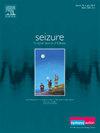cenobamate治疗lenox - gastaut综合征的有效性和安全性:一项在西班牙进行的多中心真实世界研究
IF 2.8
3区 医学
Q2 CLINICAL NEUROLOGY
引用次数: 0
摘要
目的enox - gastaut综合征(LGS)是一种罕见的难治性癫痫,属于发育性和癫痫性脑病(DEE)。在这项研究中,我们调查了在现实世界条件下,cenobamate (CNB)作为成人LGS的辅助治疗的有效性和安全性。方法回顾性分析8个不同地点诊断为LGS并使用CNB的患者的临床资料。数据来源于患者临床记录。以发作类型(总发作、局灶性发作、全身性强直-阵挛发作[GTCS]、下降发作和非典型缺席)评估疗效,包括3、6和12个月时≥50%、≥75%、≥90%的应答率和发作自由率。同时分析联合抗癫痫药物(co-ASM)数量的变化。通过记录不良事件(AE)和导致停药的AE的发生率来监测安全性/耐受性。结果18例LGS患者纳入分析,其中34.4%为女性,平均年龄25.2岁,平均每月发作次数195次(IQR: 12-1416)。先前asm数和伴随asm数的中位数分别为12 (IQR: 8-16)和3 (IQR: 2-6)。在3个月、6个月和12个月时,CNB的中位剂量为200 mg /天(IQR: 50-350)。在3个月、6个月和12个月时,分别有94.4%、94.4%和83.3%的参与者继续接受CNB治疗。在最后一次就诊时,癫痫发作自由率为12.5%,≥50%,≥75%,≥90%,应答率分别为46.2%,23.1%和0%。36%的患者同时发生asm的次数减少。发生不良反应和不良反应导致停药的患者比例为0%。最常见的ae是嗜睡、精神迟钝或头晕。结论:在本研究中,CNB在LGS患者多次asm失败后作为佐剂使用时显示出较高的有效性和良好的耐受性。ae经常发生,但大多是轻度到中度的。本文章由计算机程序翻译,如有差异,请以英文原文为准。
Effectiveness and safety of cenobamate in Lennox-Gastaut syndrome: A multicenter real-world study in Spain
Objective
Lennox-Gastaut syndrome (LGS) is a rare treatment-resistant epilepsy classed as developmental and epileptic encephalopathy (DEE). In this study we investigated the effectiveness and safety of cenobamate (CNB) as adjunctive therapy in adults with LGS under real-world conditions.
Methods
We conducted a retrospective analysis of clinical data collected from patients diagnosed with LGS who were prescribed CNB in 8 different sites. Data was sourced from patient clinical records. Effectiveness was evaluated by seizure type (total seizures, focal onset seizures, generalized tonic-clonic seizures [GTCS], drop seizures and atypical absence) and included ≥50 %, ≥75 %, ≥90 % responder rate and seizure freedom rate at 3, 6 and 12month visits. Changes in the number of co-antiseizure medication (co-ASM) were also analyzed. Safety/tolerability was monitored by documenting the incidence of adverse events (AE) and AEs leading to discontinuation.
Results
18 patients with LGS were included in the analysis (34.4 % women, mean age 25.2 years, and median number of seizures per month 195 (IQR: 12–1416)). The median of number of prior ASMs and concomitant ASMs were 12 (IQR: 8–16) and 3 (IQR: 2–6) respectively. Median CNB dosages/day was 200 mg (IQR: 50–350) at 3, 6 and 12 months. At 3, 6, and 12 months, 94.4 %, 94.4 % and 83.3 % of participants were retained on CNB treatment, respectively. At the last available visit, the seizure freedom rate was 12.5 %, ≥50 %, ≥75 %, ≥90 % responder rates were 46.2 %, 23.1 %, and 0 %, respectively. The number of co-ASMs was reduced in 36 % of patients. The percentage of patients with AEs and AEs leading to discontinuation was 0 %. The most frequent AEs were somnolence and bradypsychia or dizziness.
Conclusion
In this study, CNB demonstrated high effectiveness and good tolerability in patients with LGS when administered in adjuvancy in real-world practice after the failure of multiple ASMs. AEs were frequent but mostly mild-to-moderate.
求助全文
通过发布文献求助,成功后即可免费获取论文全文。
去求助
来源期刊

Seizure-European Journal of Epilepsy
医学-临床神经学
CiteScore
5.60
自引率
6.70%
发文量
231
审稿时长
34 days
期刊介绍:
Seizure - European Journal of Epilepsy is an international journal owned by Epilepsy Action (the largest member led epilepsy organisation in the UK). It provides a forum for papers on all topics related to epilepsy and seizure disorders.
 求助内容:
求助内容: 应助结果提醒方式:
应助结果提醒方式:


